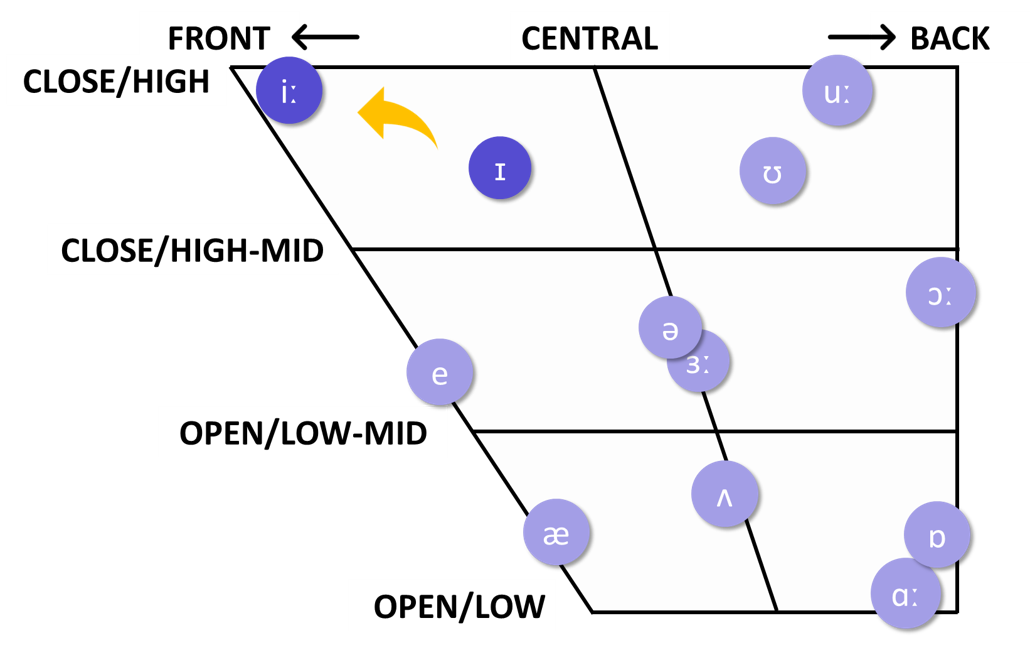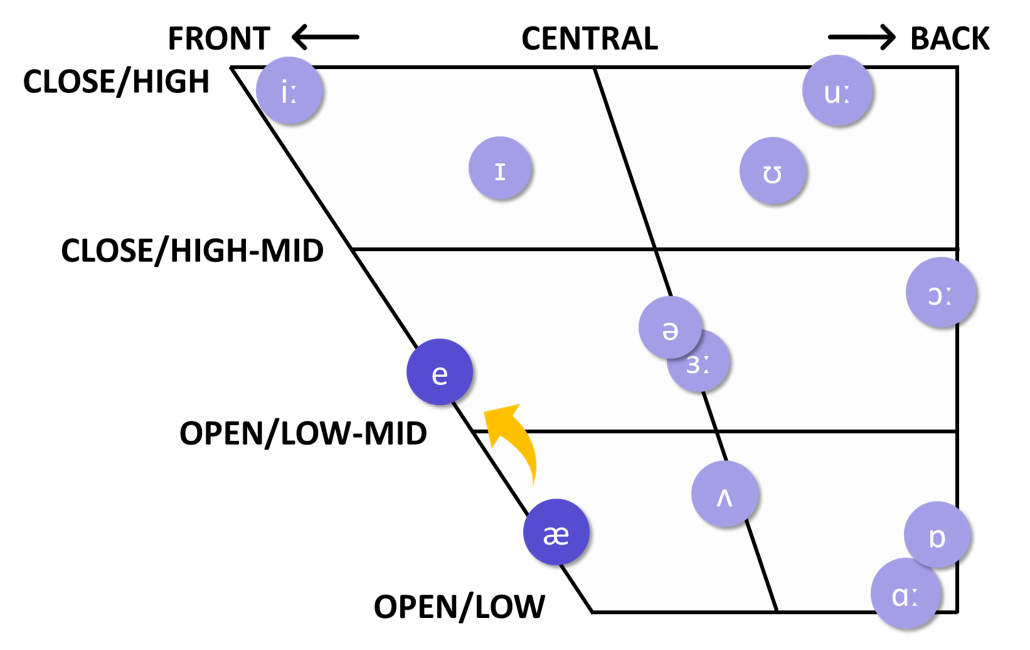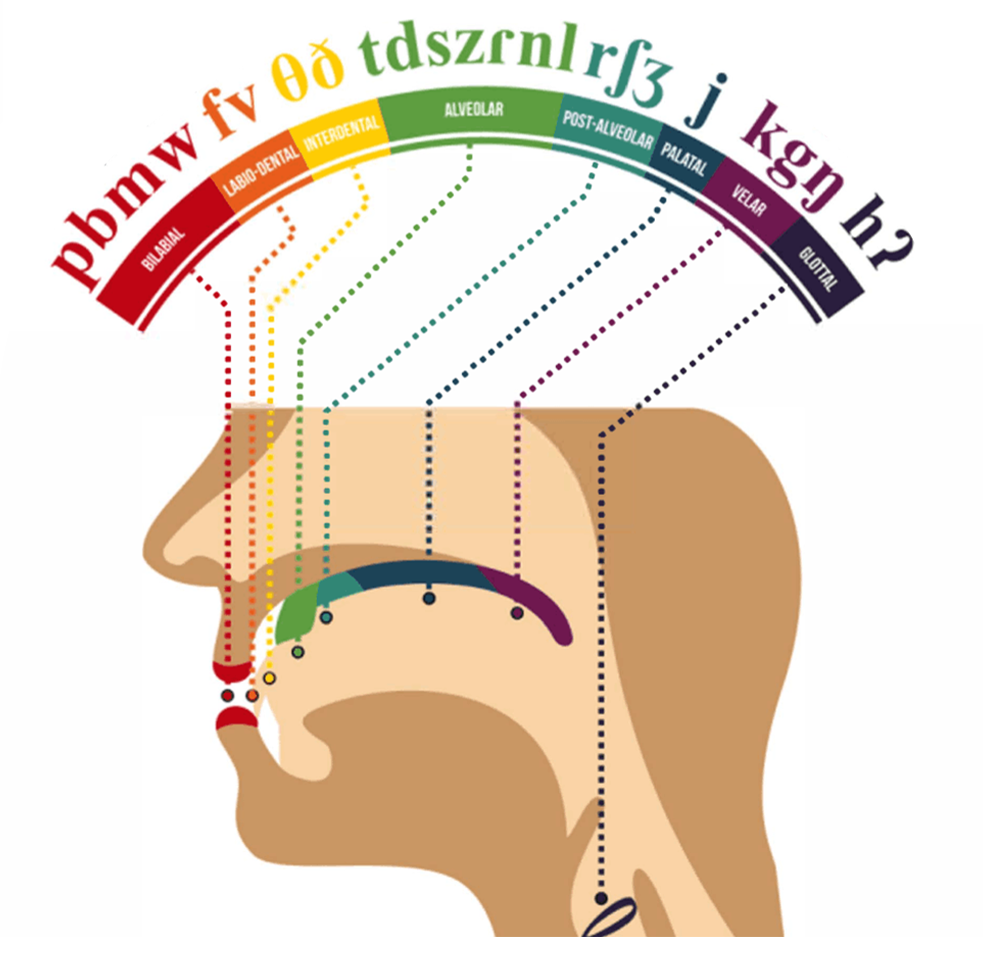
Throughout the three phases of our project, we identified and summarized the distinctive phonological features of English and Mandarin by learners from Hong Kong and Guangdong with different levels of proficiency. English and Mandarin teachers are strongly encouraged to take both language backgrounds and proficiency levels of their students into consideration, and use our summary to guide their pronunciation teaching focus and material design.
Notes: HKH, HKL, GDH and GDL used in the table below represent learners from different regions with varying levels of language proficiency. HK and GD refer to learners from Hong Kong and Guangdong province, respectively. The letters ‘H’ and ‘L’ following HK and GD indicate the learners’ language proficiency levels, either high or low.
English Feature
Mandarin Feature
Segmental
V1. Pure vowel substitution

Learners’ performance of the vowel sound /ɪ/ varies with their language background and proficiency: GDL>HKL>GDH>HKH.
Recordings
– clip (in word read-aloud task)
HK02
GD02
– fist (in passage read-aloud task)
HK04 (fist)
HK04 (rising his fist in the air)

Learners’ performance of the vowel sound /ʊ/ varies with their language background and proficiency: GDL>GDH=HKH.
Recordings
– book
HK10
GD04

Learners’ performance of the low front short vowel /æ/ varies with their language background and proficiency: GDL>HKL>GDH>HKH.
Recordings
– scan
HK07
GD03
V1. ‘Vowel + Nasal’ rhyme substitution
This feature can be only found in HKL and HKH learners (HKL>HKH).
Recordings:
– 翁
HK09
This feature can be in all groups of learners (HKL>GDL=GDH>HKH).
Recordings:
– 恆
HK02
GD01
V2. Erhua
This feature can be found among GDL, GDH and HKL learners (GDL>GDH=HKL).
Recordings:
– 爾
HK07
V*. Vowel features found in disyllabic words
This feature can be in three groups of learners (HKL>GDL=GDH).
Recordings:
– 不能
HK02
This feature can be found among all groups of learners (HKL>GDL>HKH>GDH).
Recordings
– 圓圈兒
HK09
GD02
This feature can be found among three groups of learners (GDL>HKL>GDH).
Recordings
– 圓圈兒
HK07
C1. Devoicing

Learners’ performance of the voiced post-alveolar fricative /ʒ/ varies with their language background and proficiency: GDL>HKL>GDH>HKH.
Recordings
– treasure
HK03
GD04
C1. Consonant substitution
Learners’ performance of the consonant sound ‘zh’ varies with their language background and proficiency: GDL>HKL>HKH>GDH.
Recordings
– 缀
HK02
Learners’ performance of the sound ‘z’ varies with their language background and proficiency: HKL>GDL>HKH.
Recordings
– 阻
HK09
C2. Consonant(s) substitution with non-English sound(s)
Learners’ performance of the consonant cluster /dr/ varies with their language background and proficiency: GDL>GDH>HKL>HKH.
Recordings
– dry
GD01
* [ʈ͡ʂ]: Chinese ‘zh’
C2. Non aspiration
Learners’ performance of the Mandarin sound ‘p’ varies with their language background and proficiency: GDL>HKL>GDH>HKH.
Recordings:
– 胚
HK02
C3. Aspiration
Learners’ performance of /k/ sound in consonant clusters varies with their language background and proficiency: GDL>HKL>GDH>HKH.
Recordings
– scan
C*. Consonant features found in disyllabic words
Learners’ performance of ‘ch’ sound varies with their language background and proficiency: GDL>HKL>HKH>GDH.
Recordings
– 小吃
HK09
Learners’ performance of ‘sh’ sound varies with their language background and proficiency: HKL>GDL>HKH.
Recordings:
– 結束
HK09
Learners’ performance of ‘zh’ sound varies with their language background and proficiency: GDL>HKH>HKL>GDH.
Recordings:
– 一致
HK02
Suprasegmental
S1. Tone
This feature can be found among all groups of learners (GDL>HKL>GDH>HKH).
Recordings
– 垮
GD01
S*. Lack of neutral tone (tone 0)
This feature can be found among all groups of learners (GDL>HKL>GDH>HKH).
Recordings:
– 護士
HK09
– 觉得
GD01
This feature can be found among all groups of learners (GDH=GDL>HKH>HKL).
Recordings:
– 餃子
HK02
GD01
This feature can be found among all groups of learners (GDH=GDL>HKH=HKL).
Recordings:
– 舒服
HK02
GD01
S*. Tone sandhi
This feature can be found among three groups of learners (HKL>HKH>GDL).
Recordings:
– 一本
HK02
This feature can be only found among Hong Kong learners (HKL>HKH).
Recordings:
– 廣場
HK02
This feature can be only found among Hong Kong learners with low proficiency (HKL).
Recordings
– 不能
HK02
In addition, we also summarized the strategies for learning English and Mandarin adopted by participants in our project. All the strategies were further categorized based on six dimensions proposed by Oxford (1999), including memory, cognitive, compensation, metacognitive, affective and social.
Strategies for learning English
Strategies for learning Mandarin
HK learners
GD learners
HK learners
GD learners
memory
– Learning phonics
– Applying images (e.g. tongue position, lips shape, face and throat muscles)
and sounds by using imagery and keywords
– Reviewing
– Looking up the IPA in the dictionary
– Learning Pinyin
cognitive
– Watching movies or TV programs;
– Listening to native speakers’ pronunciation (mainly from dictionaries)
– Analyzing contrastively
– Watching movies or TV programs;
– Listening to native speakers’ speech
– Watching TV programs (including TV dramas and entertainment shows)
– Learning from the hosts of national TV stations;
– Watching TV programs (including TV dramas and entertainment shows)
compensation
metacognitive
affective
– Encouraging and rewarding yourself to lower anxieties and gain confidence
social/cooperation
– Asking for correction;
– Communicating with native speakers as much as they can
– Communicating with classmates whose L1 is Mandarin
– Communicating with classmates whose L1 is Mandarin
